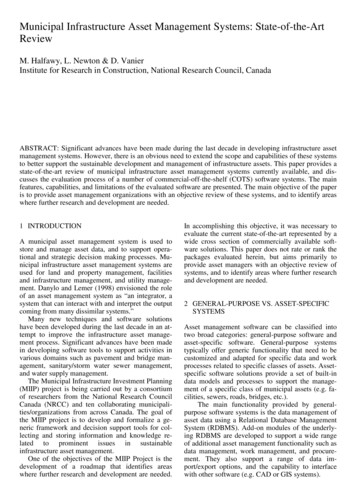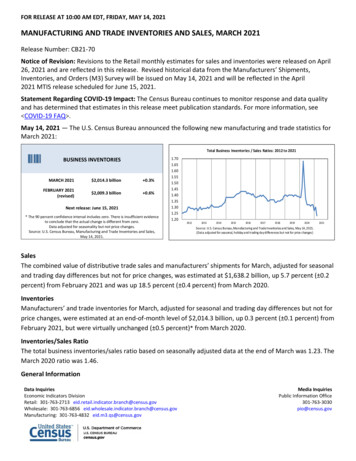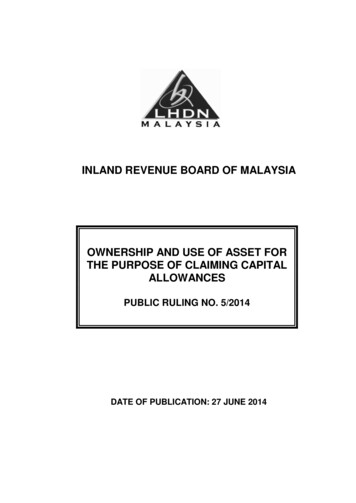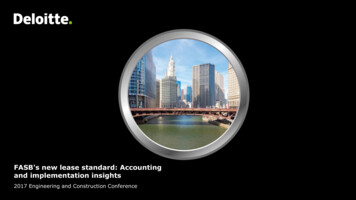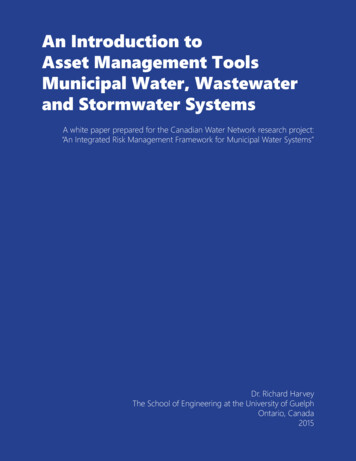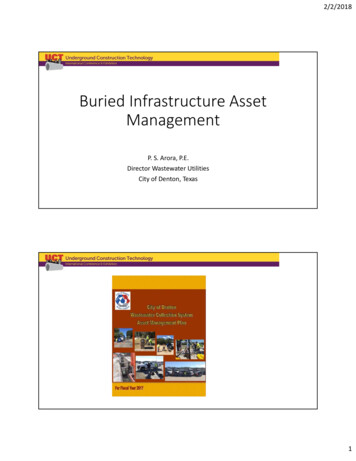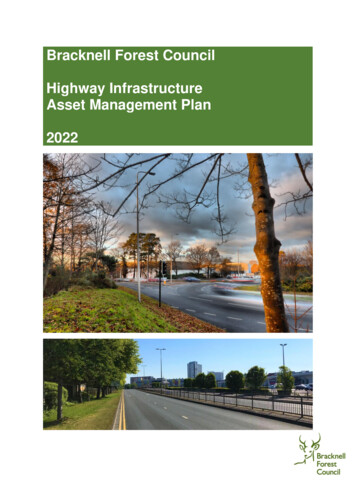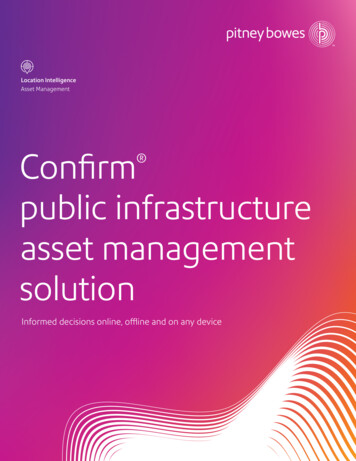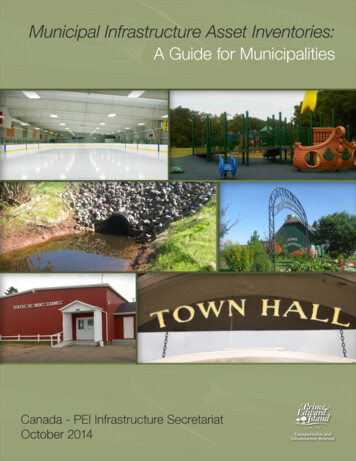
Transcription
Municipal Infrastructure Asset Inventories:A Guide for MunicipalitiesCanada - PEI Infrastructure SecretariatOctober 2014
Local governments have an obligation to provide safe and useful infrastructure to their ratepayers, and byemploying principles and concepts that form the basis of asset management they will be able to achievethis while saving time and money. Asset management evaluates risk, prioritizes spending and provides amunicipality with the tools to efficiently manage and maintain its infrastructure.The Federal and Provincial Governments recognize that asset management is a valuable tool for long-termstrategic planning and have incorporated it into the latest Gas Tax Agreement. While it’s not currently aprerequisite for receiving funds, the agreement indicates that it will be by March 2018. In an effort to aidmunicipalities on their path to better asset management the Infrastructure Secretariat has created a plan,which will be carried out over the next several years. The plan will see each municipality develop acomprehensive infrastructure asset inventory, evaluate the current condition and performance of theirinfrastructure and outline all anticipated costs associated with operation and maintenance.Asset management is not intended to be a one-time exercise—over time, the infrastructure in ourcommunities will deteriorate, while populations will grow and decline. To account for this, the needs ofeach municipality as well their infrastructure must be continuously re-evaluated.The Asset Inventory Forms have been created so that the municipalities of Prince Edward Island can listand report on the infrastructure that they own and maintain. This is the first step, or phase, in the plan toimplement infrastructure asset management for PEI. Municipalities are requested to complete these formsand submit them to Alex Dalziel at the Infrastructure Secretariat office by January 23, 2015.Alex DalzielInfrastructure SecretariatDepartment of Transportation & Infrastructure Renewal75 Fitzroy Street, 3rd Floor, Suite 303, Charlottetown, PE C1A 1R6Phone: (902) 620-3631Fax: (902) 620-3383E-Mail: M
TABLE OF CONTENTSSections1 – Introduction .42 – General Guidelines For Filling Out Asset Inventory Forms .53 – Asset Classes/Categories .64 – Assessment Assigning Asset ID Numbers .75 – Working Through The Sections of Form (A) .106 – Instructions For Saving Your File .17AppendicesAppendix A – Definitions .183
1 – INTRODUCTIONThe main focus of this phase will be to list each and every asset owned and maintained by yourmunicipality. The information being collected in these forms is essentially limited to name and location, aswell as some other basic information regarding usage and annual expenses. It is important to not get hungup on any items or figures that are harder to track down; for now, estimates can be used as place holderswith the understanding that more accurate information will be entered in the future.The Province recognizes that there are several municipalities who have already begun pursuing strategiesfor improved asset management. Those municipalities are encouraged to continue working on what theyhave as long as they are meeting the minimum requirements that the other municipalities will be held to.This is the first installment of asset inventory forms and will document the following municipalinfrastructure: Buildings/Facilities, Parks, Athletic Fields, Cultural and Tourism Infrastructure, Trails andLand. The second installment of forms will be released within the next 6-12 months and will deal with therest of the asset types including: Water/Wastewater, Storm Water Management, Road/Sidewalks andPublic Transit.It is highly recommended that municipalities fill out these forms via computer. Municipal administrationsmust have access to Microsoft Office in order to do this. If your municipality does not have MS Office,please contact the Infrastructure Secretariat office for assistance. Furthermore, the inventory forms aswell as this guide were created using MS Word 2007. The appearance of menus and options depicted inthis guide may differ if you are using other versions of MS Word.By completing these forms, local governments will have assembled a complete and thorough inventory ofthe infrastructure for which they are responsible. Municipalities can also expect to receive a version oftheir inventory in Microsoft Excel format which will be put together by the Infrastructure Secretariat. Thisinventory spreadsheet will be expanded to include more information through future phases, but mostimportantly it will be used to ensure that optimization and sustainability are at the forefront of all futureplans of infrastructure management.4
2 – GENERAL GUIDELINES FOR FILLING OUT ASSET INVENTORY FORMSMunicipalities are asked to complete and submit these forms by January 23rd, 2015. Electroniccopies of the forms can be submitted via email to Alex Dalziel - jadalziel@gov.pe.ca. Alternatively,hard copies of the completed forms can be delivered in person or mailed to:Infrastructure Secretariat75 Fitzroy Street, 3rd Floor, Suite 303Charlottetown, PE C1A 1R6Complete one (1) form for each individual asset. If you have more than one building, park, athleticfield, etc., you must fill out a separate form for each of themFill in only the white areas of the form. The boxes that are grey in color are either title boxes or foroffice use only. Please do not edit or change any information in the grey boxesSave each file under the asset’s identification number. More detailed instructions for saving yourwork can be found in Section 6. Save your file as often as you can; if for some reason your progressis lost or tables of the form become misaligned then you should have a saved file to revert back toIt is important to consider each asset as a standalone item. If your community hall has a park or abaseball field on the same property do not group them together; fill out a separate form for eachThis document is to be filled out to the best of the municipality’s ability in order to ensure that themost accurate and up to date information is being presented. In the case where an exact date oramount is not known, please use your best judgment in determining an appropriate value. Moreaccurate values and descriptions can be added in the futureNot all municipalities are going to have assets in each asset class. Please ignore those forms that donot pertain to your municipalityInclude infrastructure only. Municipalities were required to report on items like tools, furniture,electronics, appliances, etc., for the PSAB 3150 Tangible Capital Assets Reporting, but they are notrequired to for this exercise. This does not excuse municipalities from any reporting requirementsor commitments they might already have on non-infrastructure assetsDocument only the infrastructure that your municipality is responsible for. Inventories can beexpanded later to include infrastructure owned by not-for-profit organizations and other nongovernmental groups, but for now only focus on what your municipality ownsDefinitions of various terms found throughout the document can be found in Appendix A5
3 – ASSET CLASSES/CATEGORIESThe list below outlines several different categories your infrastructure assets could fall under:Form (A) will address the following categories of assets: A.1 – BUILDINGS/FACILITIES: All municipal buildings (town halls, storage buildings, libraries,museums, theatres) as well as recreation facilities (gymnasiums, hockey arenas, indoor soccercomplexes). This category also includes facilities that house water and wastewater treatmentequipment, but not the equipment itself. A.2 – PARKS: All municipal parks, gardens, playgrounds and green spaces, etc. A.3 – ATHELETIC FIELDS: All outdoor athletic fields including soccer fields, baseball diamonds, rugbyfields, football fields, etc. A.4 – CULTURAL/TOURISM: An historic site, statue, sign, commemorative plaque, somethingsimilar having historical significance or that is used to attract tourists. A.5 – TRAILS: All walking/hiking/biking trails. A.6 – LAND: Woodlots, fields, vacant properties.Form (B) will be released later and will deal with the following assets: B.1 – WATER DISTRIBUTION: There are a number of subcategories under water distribution such aswell fields, wells, valves, water storage tanks, pipe networks and fire hydrants. B.2 – WASTEWATER MANAGEMENT: There are a number of subcategories under wastewater suchas lagoons, pumping stations, pipe networks and manholes. B.3 – STORM WATER MANAGEMENT: There are a number of subcategories under storm watermanagement such as catch basins, manholes and pipe networks. B.4 – ROADS: Streets, highways, roads, etc. B.5 – SIDEWALKS: Concrete or asphalt walkways located off the shoulder of the road or street.Walking and running trails are not to be included in this asset class. B.7 – PUBLIC TRANSIT: All equipment associated with public transit, including buses, vans and busshelters.6
4 – ASSIGNING ASSET IDENTIFICATION NUMBERSThere is a space reserved for asset identification numbers in the first section of each of the forms. Thefollowing section explains why asset IDs are important and how to assign them.Assigning each of your infrastructure assets their own serial or identification number is very importantwhen compiling an asset inventory. It is necessary to have a distinct and individual number for lengths ofpipe, road, sidewalk, etc., as they often have no other means of identification. Larger items like buildingsor facilities are also easier to manage when they each have their own reference number.Having a unique identification number for each of your assets will also be very important should yourmunicipality adopt an asset management software package in the future.Asset IDs are divided into three parts; Part 1 - Municipality Number, Part 2 – Asset Class and Part 3 AssetNumber. The diagram below shows how asset numbers are assigned:Municipality NumberAsset Number1395 – 04 – 00341Asset Class7
Part 1 – MUNICIPALITY NUMBERThe municipality number is a number that was assigned by Municipal Affairs and can be found on the 35161534Abrams VillageAftonAlbertonAlexandraAnnandale-Little Pond-Howe adalbaneBrudenellCardiganCentral BedequeCentral KingsCharlottetownClyde RiverCornwallCrapaudDarlingtonEastern KingsEllerslie-BidefordGeorgetownGrand er RiverKensingtonKingstonKinkoraLady SlipperLinkletterLorne ValleyLot 11 & AreaLower MontagueMalpeque 5MeadowbankMiltonvale ParkMiminegashMiscoucheMontagueMorellMount StewartMurray HarbourMurray RiverNew Haven-RiverdaleNorth RusticoNorth ShoreNorth WiltshireNorthportO'LearyPleasant GroveResort MunicipalitySherbrookeSourisSouris WestSt. FelixSt. LouisSt. NicholasSt. Peters BayStratfordSummersideTignishTignish ShoreTyne ValleyUnion RoadValleyfieldVictoriaWarren GroveWellingtonWest RiverWinsloe SouthYork8
Part 2 – ASSET CLASS NUMBERThe second number describes the asset class, or type of asset. Asset class numbers can be found in thefollowing 324Buildings – Administration – Municipal OfficeBuildings – Administration – Meetings/ConferencesBuildings – Administration – OtherBuildings – Recreation – Hockey ArenaBuildings – Recreation – Gymnasium/Fitness CenterBuildings – Recreation – Curling RinkBuildings – Recreation – OtherBuildings – Service – Police StationBuildings – Service – Fire HallBuildings – Service – OtherBuildings – Utility – Water Treatment BuildingBuildings – Utility – Electrical Utility BuildingBuildings – Utility – OtherBuildings – Arts – LibraryBuildings – Arts – MuseumBuildings – Arts – TheatreBuildings – Arts – OtherBuildings – Storage – Machinery/Vehicle StorageBuildings – Storage – Goods StorageBuildings – Storage – OtherBuildings – OtherParksAthletic lic TransitWater – PipeWater – Well FieldWater – WellsWater – PumpsWater – Fire HydrantWater – Storage TanksWater – ValvesWater – Misc. Water EquipmentWastewater – PipeWastewater – Treatment LagoonWastewater – Pumping StationsWastewater – Water Treatment FacilitiesWastewater – Misc. Wastewater EquipmentWastewater – ManholesStorm Water Management – PipesStorm Water Management – Catch BasinsStorm Water Management – ManholesIf your municipality owns an asset that is not adequately described in any of the 46 categories then pleaseselect “#26 – Other” as the asset class. Form A.7 has also been created to address those assets that do notfit into any other category. For Multi Purpose Buildings/Facilities, select the asset class which the buildingis most recognized for, or closely associated with and use the corresponding number as the asset classnumber.Part 3 – ASSET NUMBERThe third number on the list is arbitrarily assigned by the municipality. This number is simply meant todescribe the asset’s place in the asset class and is by no means an indication of the asset’s priority orimportance. To assign Asset Numbers, start at 00001 and proceed in increasing order until all of yourassets in that class have their own unique number.Example: If Stratford has two hockey arenas, their corresponding asset ID numbers would be:2475-04-00001 and 2475-04-00002.9
5 – WORKING THROUGH THE SECTIONS OF FORM (A)The Asset Inventory Forms have been developed as a simplified solution to documenting infrastructure oflocal governments. Upon completion, these forms will produce a catalogue of every infrastructure assetfor which your municipality is responsible. Details on how to fill out the various sections of the inventoryforms is thoroughly described in the following section.Begin by first filling out the name of your municipality as well as the current date. To do this, double-clickon [NAME OF MUNICIPALITY] and [DATE] which will allow you to access and edit the header. You will onlyneed to do this once per form, as the rest of the document will be automatically updated.After editing the header with the date and name of municipality, proceed to the footer where you willdouble click on [NAME OF ASSET]. Like the header, you will only need to do this once as the rest of thepages in the document will be automatically updated. Be sure to change only the name of the asset andnot the page number.10
NOTE: If you are filling the forms out by hand, please mark down the name of your municipality, date andname of your asset beside the appropriate fields. If there is a picture available, insert it into the allottedspace. It will help to further identify the asset in the future.To insert a picture, highlight the text“INSERT PICTURE HERE”, in the boxwhere space has been reserved forphotos. Go to the menu along the topof the screen and locate the “Insert”option. Click on “Picture” and locatethe file, or photo, that you wish toinsert. After you insert the picture, itmay need to be resized so that it doesnot disrupt the format of the rest ofthe form.Proceed with filling out the fields with Name, Community, Civic Address, Year that the asset wasconstructed, etc. All information to help with filling out Asset ID Number can be found in the previoussection (4.0 – ASSIGNING ASSET IDENTIFICATION NUMBERS). After the basic information has beenentered, move on to General Information. Depending on the category of asset, this section will containroom for a brief description and some physical characteristics of the asset. The asset class depicted in theexample below is for BUILDINGS/FACILITIES.In some cases the square footage may not be known. In this case, a rough estimate will suffice.Example: A 3 storey building is 50 feet long and 60 feet wide. The estimated square footagewould then be 50’ x 60’ 3000 x 3(stories) 9000 sq ft.For Wall Construction, Exterior Siding, Roof Type and Roof Construction please select one of the choicesoutlined in the form. If any of these items are not known, please indicate by marking “unknown”. If thebuilding is constructed of something other than what is listed then provide a brief description.11
After completing the general information section, proceed to Current Use(s). For PARKS, ATHLETIC FIELDS,etc., the section for current uses is grouped in with general information. All that is required here is a briefdescription of what the building is commonly used for.For BUILDINGS/FACILITIES, the current use section is shown below:There are several typical building uses listed, as well as subcategories of each so be sure to check all thatapply to your building. If the current use of your building does not fall into one of the categories listedabove then please briefly indicate the current use in the space provided next to line 21.Example: For a multi-purpose facility that has a gymnasium with a stage, meeting rooms,municipal offices and an attached garage you would mark an “X” next to the following:01-Municipal re and18-Machinery/Vehicle StorageThe last field to fill in under Current Use(s) pertains to Multi-Purpose Facilities only. If it has multiple uses,then please indicate what the building’s primary use is. This will be used to form the asset ID number andultimately assign the building into the appropriate category. If your building does not have multiple usesthen leave this field blank.The next section of the form will vary depending on the type of asset but should resemble the following:12
Information pertaining to all additional structures and services will be entered in this table. Examplesinclude washroom facilities, benches, lighting, parking lots, etc. The example below shows what thissection might look like when filled out:IMPORTANT NOTE FOR BUILDINGS: While it is necessary for each asset to have its own individual asset IDand subsequent form, buildings smaller than 300 square feet or the size of a small shed can be grouped inor associated with a larger asset such as a building, park or baseball field. In other words, do not fill out aform for smaller buildings. Include these smaller structures in the Additional Structures section.For buildings, there is an extra section that is used to document Mechanical, Electrical and SystemsInformation and resembles the following:13
Some of the fields in the “service” column have already been filled in as suggestions, however, some rowsmay not apply to your building—these fields can be left blank. There is also room under these suggestionsfor services that weren’t mentioned. To complete this table, fill out the year in which the service wasinstalled, the type of service (oil/wood/electric, private well/municipal water service, 100Amp/200Amp,etc.) and any upgrades or repairs that were completed since installation.The next section of the forms is where the asset’s Financial Information will be entered. If there are fieldswhere there is no information to report, please enter “ 0.00”.Life Cycle Cost analysis identifies every dollar that will be spent on an asset over its entire life span and willbe the focus of later phases in the asset management plan. Life Cycle Costs consist of capital (cost ofconstruction or purchase), operating, maintenance and decommissioning (demolition, removal) costs. Forcertain projects, the focus is often on capital costs while some operating and maintenance costs gooverlooked. In many cases the capital costs of a project can be as low as 20-25% while operation andmaintenance costs can account for up to 70-75% of the overall life cycle costs. The next section willdocument Annual Costs (operation and maintenance) and Revenues and will create a foundation of LifeCycle Cost analysis for which municipalities can build on in the future.Certain fields are asking for annual costs or revenues. As these values often differ from year to year, allthat is required is an average for the previous 5 years. If information from the last 5 years does not exist,or isn’t available then proceed with what information you have. These figures don’t necessarily have to be100% accurate; this section is mainly intended to give local governments a snapshot of the financial stateof their infrastructure assets on an annual basis.14
1. Annual Amortization Costs are costs associated with the purchase or construction of an asset and are toinclude any recurring payments being made to a financial institution or lending agency.2. Average Annual Operating Costs are fixed costs that are usually invoiced on a monthly or yearly basis.Examples include utility, electricity, heat, insurance, cable, internet, janitorial services, etc. These areanticipated costs that are necessary for the overall operation of the asset.3. Average Annual Maintenance Costs are incurred on a less routine basis and are the result of the asset’sage and usage. Examples include roof repair, window replacement, furnace and burner service, andasphalt patching in a parking lot.There is often confusion surrounding the difference between operating and maintenance costs.The following example outlines operating and maintenance costs for a car:Operating costs include registration, inspection and insurance fees as well as day to daynecessities such as gas, windshield washer fluid, etcMaintenance costs are incurred through oil changes, scheduled check-ups, tire rotations andrepairs from collisions.4. Other Misc. Annual Costs are to include any other costs associated with the asset on a yearly basis,aside from operation and maintenance. If you are unsure whether a cost should be documented underoperation or maintenance then include it on this row.5. Total Annual Expenses (1 2 3 4) is the sum of each of the previous 4 rows (amortization, operation,maintenance and miscellaneous) and provides a yearly expense total.6. Average Annual Income is to include any income that the asset generates and if applicable, shouldinclude all revenue received from rental fees, funding, donations, fundraisers, etc. Similar to annualexpenses, an average should be taken over the last 5 years.7. Annual Net Income is found by subtracting line 5 (Total Annual Expenses) from line 6 (Average AnnualIncome)The next section is General Costs, and consists of Insured Value/Replacement Cost and Annual BudgetedAmount For Emergency Repairs.To get the Insured Value of the asset, consult your insurance provider to see what the anticipated cost forreplacement is. Since you aren’t going to have insurance for every single infrastructure asset in yourmunicipality, you may need to determine the current Replacement Value by other means such as:-Inflated Capital Cost: If the information is available, use the original cost of construction oracquisition and inflate the price to the current yearAppraisal Cost: Consult a land and property appraiser to determine the current value15
-Reproduction Cost: Consult a contractor or engineer to determine what the cost would be tocompletely reconstruct the asset, or purchase a new versionThe second line of General Costs is for Annual Budgeted Amount for Emergency Repairs. This will notapply to every asset as it’s not always necessary, but if there is an amount of money that is continuouslyset aside for emergency maintenance and repairs then enter it in this field.Although there is no section for decommissioning costs, municipal administrations are encouraged to startthinking about them as their assets age and deteriorate. These costs are often overlooked andunderestimated and can typically range anywhere from 2.00 - 10.00 per square foot for a building.The last section is Additional Information. This space is reserved for any important information that didn’tfit into any of the other sections of the forms. This could include specific information about your asset suchas:“The building is nearing 15 years old. Roof may need to be re-shingled in the next few years.”“The usage of the park has gone up within the last few years, as younger families move into ourmunicipality. We will explore the possibility of adding a small centre on the property and to also pavethe parking lot.”“There have been complaints received that the dressing rooms of the hockey arena are too small anddon’t provide enough space for larger teams. The municipality will explore options to expand the sizesof the rooms in the coming years.”“Warranty on the building’s windows has expired.”16
6 – INSTRUCTIONS FOR SAVING YOUR FILEAfter you complete a form, you will want to save it under a name that will be easily identifiable. Using afilename such as “Morell Community Hall.doc” may work for larger infrastructure such as buildings andparks but will not be possible for assets such as buried water/wastewater pipes, roads, etc. On top of this,the Infrastructure Secretariat office is anticipating receiving a multitude of forms from each municipality.To account for this we will be proceed using one universal filing method. Each administration is asked tosave each file under the asset’s corresponding identification number. Assigning asset IDs is described insection 4 of this document.The format for saving files is as follows:Below are a few examples. Note that these examples do not necessarily represent the infrastructurepresent in each of the following communities.- Kensington Community Rink would be saved as 1420-04-00001.doc- Tignish has 3 community parks. They will be saved as 1460-22-00001.doc, 1460-22-00002.doc and1460-22-00003.doc- St. Peter’s Bay has 4 different walking trails, their corresponding file names would be 3435-2500001.doc, 3435-25-00002.doc, 3435-25-00003.doc and 3435-25-00004.docAs mentioned in section 4, the last set of numbers (.-00000) does not signify importance or priority. Itssole purpose is to differentiate between all the assets in that particular category.Be sure to save your forms in a separate folder that can be easily identified. Ex: “Asset Inventory”17
Appendix A - Definitions18
AAdditional Structures – Structures found on or around an asset that contribute to the overall functionality of thatasset. Examples include: For buildings – parking lot, small storage shed, gazebo; for parks – tennis courts, washroomfacilities, playground equipment; for athletic fields – soccer nets, baseball dugouts/backstop/fence, field hockeynets; for trails – lighting, benches, interpretive plaques, pedestrian bridges;Athletic Fields – Outdoor sports facilities such as soccer, football and baseball fields. Supplementary structures suchas soccer nets, football uprights and dugouts/backstop for a baseball field should also be documented along withthe field itself.Annual Costs – Expenses that are incurred by an infrastructure asset on a yearly basis, such as operating,maintenance, amortization, etc.Anticipated Decommissioning Costs – Estimated costs for demolishing a building, removing hazardous materials orrestricting public access to a condemned park, etc.Asset – In the case of infrastructure asset management, an asset is a tangible item of value that provides a service toa community or municipality.Asset Class – Asset classes distinguish between the different categories or types of assets. For example: buildings,parks, athletic fields, water/wastewater are all different types, or classes, of assets. For a list of asset classes pleasesee Section 3. For a list of asset classes for Asset ID purposes, consult Section 4.Asset Identification Number – A unique number which is given to each of the municipality’s infrastructure assets.Asset IDs are made up of three parts: Municipality number, asset class and asset numbers. Directions for how toassign asset IDs can be found in Section 4.BBudgeted Amount For Emergency Repairs – If applicable, the amount of money which a municipality sets aside foran infrastructure asset in the event of an emergency.Buildings – Infrastructure that includes community halls, recreation facilities, storage facilities, cultural and tourismfacilities (theatres, museums), water treatment facilities.CCAO – Chief Administrative Officer. Hired by the municipality, the CAO assumes all administrative duties on behalf ofthe municipality.Capital Cost – The overall cost for the design and construction, or the purchase price.Civic Address – Civic address is a provincially-assigned address; the street address of the asset.19
Community – The community in which the asset is located. This is mainly intended for larger municipalities, whichare often comprised of several smaller communities. For smaller municipalities, the name of the municipality willsuffice for this part of the form.Example: Lower Montague, PECurrent Use – What the asset is used for (recreation, business, municipal meetings, etc)Cultural/Tourism – Infrastructure that could include, but is not limited to historical or commemorative monuments,signage or displays meant to attract tourists.DDescription of Asset – A brief description explaining what the asset is. Include type of construction (
each municipality as well their infrastructure must be continuously re-evaluated. The Asset Inventory Forms have been created so that the municipalities of Prince Edward Island can list and report on the infrastructure that they own and maintain. This is the first step, or phase, in the plan to implement infrastructure asset management for PEI.
